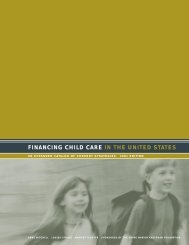Global entrepreneurship report - ResearchGate
Global entrepreneurship report - ResearchGate
Global entrepreneurship report - ResearchGate
Create successful ePaper yourself
Turn your PDF publications into a flip-book with our unique Google optimized e-Paper software.
family ownership expected within five years?” 24 The assessment<br />
was organized in relation to whether the firm had one principal<br />
owner or two or more owners. Based on the responses of the<br />
individuals <strong>report</strong>ing on the business entities, there was more<br />
than 50 percent family ownership for more than one-third of the<br />
entities: 40 percent among start-ups, 37 percent among new<br />
firms, 36 percent among established firms and 38 percent of those<br />
in the TEA index.<br />
A recurrent dilemma in such analysis is how to treat oneperson<br />
firms. Many would argue that family support is so critical<br />
that any one-person firm should be considered a family business.<br />
This involves adding all one-person businesses to the total of<br />
multiple-owner businesses with a majority of family ownership.<br />
With this modification, about three-fourths of all businesses were<br />
family owned: 74 percent of start-ups, 84 percent of new firms,<br />
88 percent of established firms and 78 percent of those in the<br />
TEA index. 25 While the use of this measure suggests that older<br />
firms are more likely to have family ownership, this probably<br />
reflects an increase in the proportion of one-person firms among<br />
older companies.<br />
Variation across countries in the proportion of family firms<br />
using this classification technique is presented in columns 4 and 5<br />
of Table 9. Using the reduced definition of a family business, the<br />
range is from 24 percent to 51 percent. With the expanded<br />
definition, the range is from 52 percent to 86 percent.<br />
How many family-owned start-ups and new firms are<br />
involved in the entrepreneurial process? Two sets of estimates,<br />
based on whether or not the one-principal entities are universally<br />
counted as family firms, are provided in Table 9. For comparison,<br />
the total number of participants is presented in the far right<br />
column. For these 10 countries the number of those involved in a<br />
family-owned business varies from 13 million to 27 million, which<br />
is one-third to three-fourths of the 38 million participants involved<br />
in these 10 countries. The estimates are based on a total of 376<br />
million individuals 18 to 64 years of age from a total population of<br />
609 million. From this analysis, it is clear that a substantial<br />
proportion of those involved in the entrepreneurial process are<br />
doing so with family-supported new ventures.<br />
Table 9: Total Entrepreneurial Activity (TEA)<br />
and Family-Sponsored Entrepreneurship for Selected Countries<br />
Total Population % Family % Family Family TEA Family TEA Count of Family Count of Family Count of<br />
Population: 18-64 Yrs Ownership of Ownership of (Low (High TEA Participants TEA Participants All TEA<br />
2002 Old: 2002 TEA entities TEA entities Estimate) Estimate) (Low Estimate) (High Estimate) Participants<br />
(Low Estimate) (High Estimate)<br />
Country Total Total Total<br />
United States 280,000,000 173,911,000 32% 75% 3.2% 7.5% 5,565,000 12,973,000 18,260,000<br />
Brazil 176,029,000 106,442,000 50% 86% 6.0% 10.2% 6,386,000 10,899,000 14,369,000<br />
United Kingdom 59,778,000 36,927,000 26% 78% 1.3% 3.8% 480,000 1,399,000 1,994,000<br />
Australia 19,546,000 12,273,000 34% 77% 2.5% 5.6% 306,000 688,000 1,067,000<br />
Spain 40,077,000 25,886,000 24% 56% 1.1% 2.5% 284,000 654,000 1,190,000<br />
Hungary 10,075,000 6,557,000 29% 80% 1.6% 4.3% 104,000 282,000 432,00<br />
New Zealand 3,908,000 2,432,000 51% 75% 4.9% 7.1% 119,000 173,000 340,000<br />
Israel 6,029,000 3,485,000 36% 76% 2.1% 4.4% 73,000 154,000 247,000<br />
Singapore 4,452,000 3,191,000 38% 65% 2.0% 3.3% 62,000 106,000 188,000<br />
Sweden 8,876,000 5,433,000 26% 52% 0.7% 1.5% 40,000 79,000 215,000<br />
Sum 608,770,000 376,537,000 13,419,000 27,407,000 38,302,000<br />
Average 34% 76% 2.5% 5.0%<br />
31
















